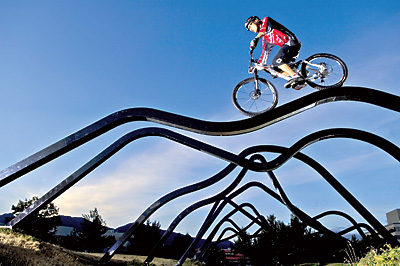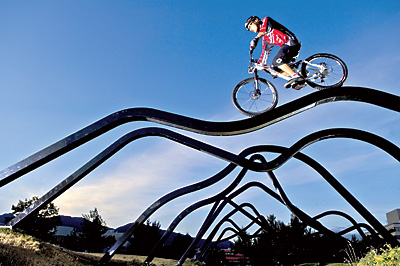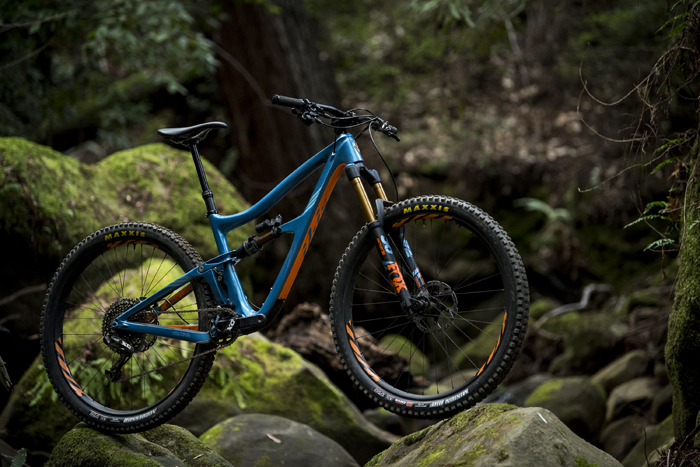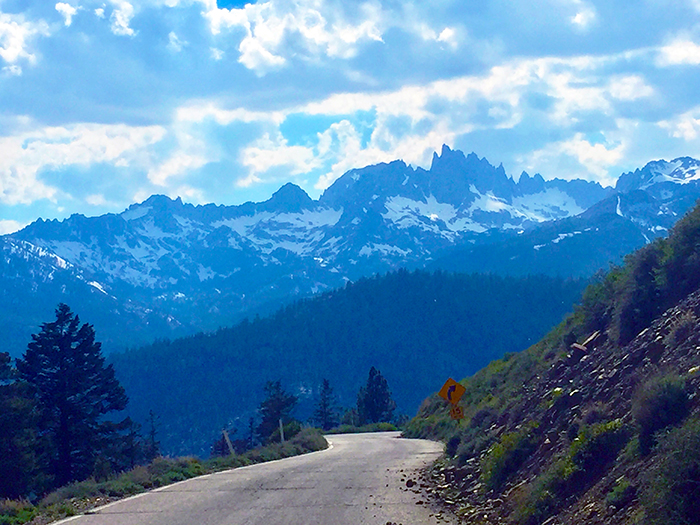- Tahoe’s Nevada Beach Tops the List of Hard-to-Book Campgrounds - 07/17/2024
- Cannabis Watershed Protection Program Cleans Up Illegal Grow Sites - 07/10/2024
- French Fire - 07/05/2024

Mountain Bike Skill Tips with Ryan Leech
By Seth Lightcap
Photo by Ian Hylands
Ryan Leech takes on an arcing skinny line filming for Kranked 5.
Whether threading the needle between cars and a curb or lining up for a log ride on your favorite single-track, confident balance in tight situations is a crucial skill for cyclists who challenge the terrain.
But learning to let your mind and body relax and roll evenly along a narrow route, elevated or on the ground, is often easier imagined than done. You’re eyes may comprehend that your two-inch tires have plenty of room to negotiate a 10-inch wide path, but convincing your brain and body to confidently follow is another story.
To jumpstart a successful season of skill progression, I caught up with legendary mountain bike trials rider Ryan Leech and picked his brain on the basics of improving your skinny skills. Based out of the freeride epicenter of the North Shore in Vancouver, B.C., Leech is well known as one of the foremost technical riders in the world. He’s appeared in epic freeride flicks such as Roam, Kranked 6, and Crux, and even performed for the Cirque Du Soleil. He also self-produced the bike skills DVD, “Mastering the Art of Trials with Ryan Leech.”
While he’s gained notoriety for riding along half-inch thick sections of wobbly chain link, Leech remembers his years as a young teenager honing his balance on a six-inch wide curb next to his driveway. Now chain-link riding may not be something you aspire to in this lifetime. But to help you make a similar progression, Leech has some hard-won words of advice from his life on the edge.
On proper approach posture … Approaching a balance feature or negotiating a tight trail section, I get in a comfortable riding posture and stand up on my pedals. I keep the pedals level with each other and keep my weight balanced fore and aft on the bike. The importance of saddle height … Saddle height is a big thing for me. I always make sure I lower my saddle before I try anything technical. It’s much safer with a lower saddle. An easy first balance obstacle worth a session …
Raised curbs are fantastic. Try to balance as long as you can on them. Great thing to practice when you’re waiting for a ride to start in a trailhead parking lot. On watching and learning … If you have a more experienced riding partner have them ride a tricky trail section and watch what they do. Observing someone else’s technique is a great way to learn. Soaking in what it’s supposed to look like is always better than going in blind.
On the importance of brake control … Knowing when to brake and when to let the wheels roll is a very important skill but it’s something you just have to experiment with. Most of your momentum is controlled with the front brake so modulating the front is crucial for speed control. I’m always monitoring both brakes though and balancing between the two based on how traction is going.
On balance recovery … It’s amazing how far off you can go when balancing on a skinny without actually falling off the side. I surprise myself all the time. My body has learned to stick with it by knowing how to lean or poke a foot out to one side. I’ll think I’m about to fall and my body and wheels just hang on …
Your muscles make a million little adjustments every second as you work to stay balanced. Don’t be afraid to use a little body English for those adjustments. Stick out your knee, foot, or shoulders when necessary. All of these recovery techniques will come automatically in the heat of the moment as long as you know they’re an option.
A good confidence-boosting drill … Riding a technical trail as slow as possible without skidding is a great challenge and amazing practice. It makes you very aware of your brake control and body positioning. Pick a trail that has a fair amount of variation and just crawl down it as slow as possible.
The best elevated obstacles to practice on … There are a million things to practice on like logs and cement planters, but the main thing I would recommend is just getting out on the trail feature you want to conquer and riding it as much as you can. If a trail section gives you problems don’t hesitate to stop and ride it again.
Scoping your escape route … If a line has a higher consequence for error take a look around before you ride it and scope out areas you might crash. Know what’s there and what’s around. Inspecting a line before riding it should give you added confidence.
Practicing for the inevitable … Good crashing technique is something you have to learn experientially. It’s not impossible to practice though. Find a balance stunt that’s not too high and practice dismounting in both directions. Try leaping off the bike and sticking with it. When an unexpected fall does occur your body will naturally go for the best option if it’s had practice in a controlled situation.
Overcoming your fear of falling … Like any sort of fear, you have to listen to it. You have to acknowledge it, and figure out what it is telling you. Perhaps it’s saying slow down or take it easy, lets try this easier line, or walk that harder line. Or maybe it’s saying lets watch this person do it first before giving it a try. You have to balance the excitement of pushing your limits with the fear messages your body is sending. So listen to your fear, understand it, acknowledge it … Your riding will improve at just the right pace and with the maximum amount of enjoyment. See Ryan Leech in action at this year’s Sea Otter Classic, April 16 – 19. He’ll be performing trials demos throughout the festival. www.seaotterclassic.com. For further info on Leech’s two-wheeled high jinx, check out www.RyanLeech.com.












